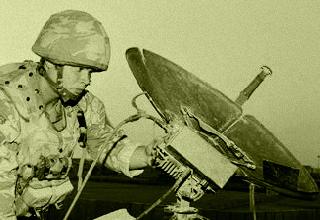
A file photo.
NEW DELHI (PTI): A border communication intelligence gathering system that would be of help to the armed forces and paramilitary in intercepting communication of terror groups across the border is likely to be inducted into the services by the end of next year.
Developed by Hyderabad-based Defence Electronics Research Laboratory (DLRL), the project envisages fitting up of 10 static and 25 mobile stations for intercepting enemy communication in the border areas.
This project is part of several electronics and computer science (ECS) related projects for the armed forces and the paramilitary being developed by the Defence Research and Development Organisation (DRDO). A laser-based ordnance disposal system is among the new projects.
Details of the new projects were given by Dr Sreehari Rao, DRDO's Chief Controller of R&D for ECS Cluster of seven labs and his colleagues at a news conference here on Monday.
DLRL Director G Boopati, in his presentation, said the communication intelligence system would be of help to both the armed forces and the paramilitary in intercepting communication of terror groups across the border.
Boopati said his lab was also working on other electronic warfare requirements of the security forces such as communication and electronic intelligence systems including jammers and integrating them on platforms.
Regarding the laser-based ordnance disposal system (LORDS), Laser System and Technology Centre (LASTEC) Director Anil Kumar Maini said the system provided the scope for destroying rockets, bombs and explosive which have completed their shelf-life without having to get closer.
The lab, he said, was in the process of integrating the LORDS on armoured vehicles so that the unwanted ordnance could be disposed of without getting any closer to it.
He said LASTEC was also working on other laser-based systems such as direct energy warfare application, low intensity conflict (LIC) applications, battlefield optoelectronic systems and advanced science and technology for future systems.
Among the LIC systems were hand held dazzlers that immobilise human targets for a few minutes, providing the much needed advantage to the security forces, apart from crowd control dazzlers mounted on vehicles and air defence dazzlers that work against enemy aircraft or helicopters.
Electronics and Radar Development Establishment's (LRDE) R Kuller said his lab was currently working on low level light radars (LLLRs) that could be deployed in mountainous areas.
He said the lab had recently tested a set of LLLRs in mountain terrains successfully. Among the LLLRs were the 'Bharani' radars for Army and 'Aslesha' radars for IAF.
Kuller said LRDE was also working on an Active Electronically Scanned Array (AESA) radar for use in future Light Combat Aircraft (LCA) 'Tejas' for both IAF and Navy, apart from a Maritime Patrol Airborne Radar (MPAR) that could track even sea-skimming missiles.
Kuller said the AESA would be ready by 2013 when its integration with LCA would be considered.
To assist the armed forces and the paramilitary in low-intensity conflict situation such as the anti-Naxal operations, the LRDE is developing ground penetrating radars for mine detection, wall penetrating and foliage penetrating radars.
 Next Article
Next Article













The Indian Air Force, in its flight trials evaluation report submitted before the Defence Ministry l..
view articleAn insight into the Medium Multi-Role Combat Aircraft competition...
view articleSky enthusiasts can now spot the International Space Station (ISS) commanded by Indian-American astr..
view article